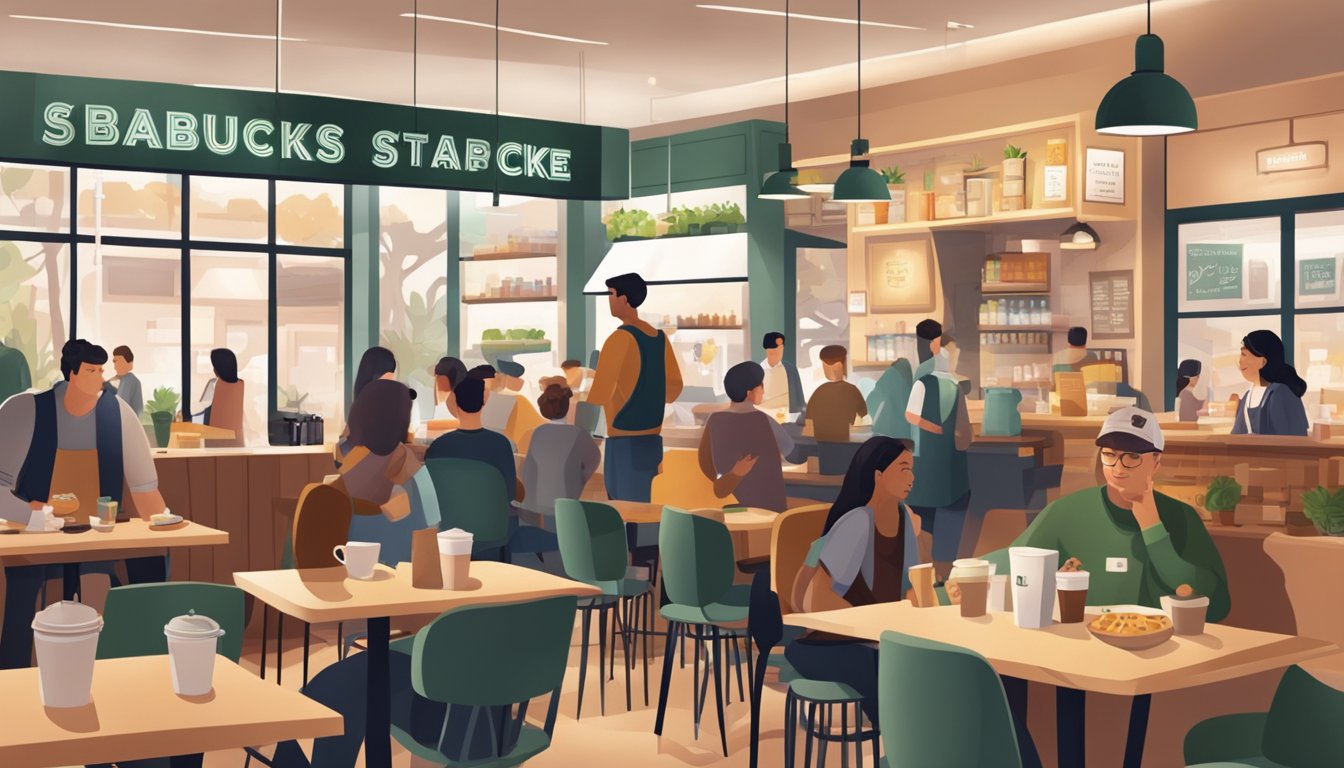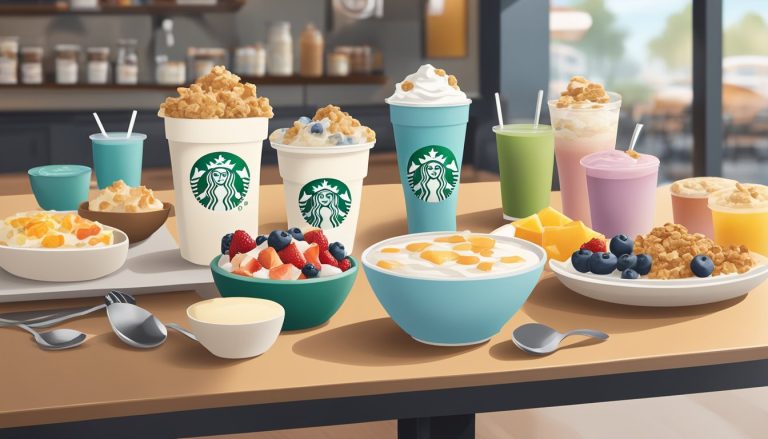Starbucks has revolutionized the coffee industry, transforming from a simple coffee shop into a global phenomenon that bridges the gap between fast food and cafe culture. The company’s innovative approach to breakfast offerings has played a crucial role in this transformation. Starbucks’ breakfast menu combines the convenience of fast food with the quality and ambiance associated with traditional cafes, creating a unique dining experience for customers.
This blend of fast food efficiency and cafe culture aesthetics has allowed Starbucks to carve out a distinct niche in the breakfast market. By offering a range of options from quick grab-and-go items to more leisurely sit-down meals, Starbucks caters to diverse customer needs and preferences. The company’s ability to adapt its breakfast menu to local tastes while maintaining a consistent brand identity has contributed to its success in various markets worldwide.
Starbucks’ breakfast strategy goes beyond just food and beverages. The company has cultivated an inviting atmosphere in its stores, encouraging customers to linger and enjoy their meals. This approach has helped Starbucks establish itself as a “third place” between home and work, where people can relax, socialize, or work while enjoying their breakfast. The result is a unique dining experience that sets Starbucks apart from both traditional fast food chains and local cafes.
The Evolution of Starbucks’ Breakfast Offerings
Starbucks has transformed its breakfast menu over the years, expanding beyond coffee to include a diverse array of food options. This evolution reflects the company’s commitment to meeting customer needs and adapting to changing tastes.
Adaption to Local Tastes and Preferences
Starbucks has tailored its breakfast offerings to suit local palates in different regions. In Asia, the company introduced congee and green tea-flavored pastries. European stores feature local breads and pastries like croissants and pain au chocolat.
In the United States, Starbucks launched protein boxes and sous vide egg bites to cater to health-conscious customers. The introduction of breakfast sandwiches in 2003 marked a significant shift towards more substantial morning fare.
Seasonal items, such as Pumpkin Spice-flavored treats, have become highly anticipated annual releases. These limited-time offerings create excitement and drive customer engagement.
Impact on Daily Lives and Routines
Starbucks’ expanded breakfast menu has changed how many people start their day. The convenience of grabbing both coffee and a meal from one location has streamlined morning routines for busy professionals.
The company’s mobile ordering system has further enhanced convenience, allowing customers to pre-order breakfast items for quick pickup. This technology has reduced wait times and improved the overall customer experience.
Starbucks’ breakfast offerings have also influenced workplace culture. Team meetings often feature Starbucks pastries and coffee, while the company’s locations serve as popular spots for morning business meetings.
The introduction of all-day breakfast items has blurred traditional meal times, catering to customers with non-traditional schedules or those seeking breakfast foods outside typical morning hours.
Customer Experience and Engagement

Starbucks has revolutionized the coffee shop experience through innovative digital initiatives and community-focused strategies. The company’s approach seamlessly blends technology with personal connection to foster customer loyalty and engagement.
Role of Mobile App and Rewards Program
Starbucks’ mobile app serves as a cornerstone of its digital customer experience. The app allows users to order and pay in advance, reducing wait times and enhancing convenience. It also integrates the Starbucks Rewards program, offering points for purchases and personalized offers.
The rewards program encourages repeat visits and increases customer lifetime value. Members earn “stars” for purchases, which can be redeemed for free drinks, food items, and merchandise. This gamification aspect keeps customers engaged and incentivizes frequent visits.
Personalized recommendations based on purchase history further enhance the app experience. Starbucks leverages data analytics to suggest new products tailored to individual preferences, driving sales and customer satisfaction.
Community Building through Coffee Shops
Starbucks positions its stores as “third places” between work and home, fostering a sense of community. The company designs its spaces to encourage social interaction and lingering, with comfortable seating and free Wi-Fi.
Store layouts often feature communal tables and cozy nooks, catering to various customer needs. This design philosophy promotes both social gatherings and individual work or study sessions.
Starbucks also engages in local community initiatives. Stores frequently host events, from book clubs to local artist showcases. These activities help integrate Starbucks into the fabric of local communities, building stronger connections with customers.
Baristas play a crucial role in community building. Starbucks trains its staff to engage with customers personally, remembering names and preferences. This personal touch creates a welcoming atmosphere and fosters customer loyalty.
Cultural Integration in Global Markets

Starbucks’ global success stems from its ability to adapt to local cultures while maintaining brand consistency. The company employs various strategies to bridge cultural gaps and establish a strong presence in diverse markets.
Howard Schultz’s Vision for Starbucks
Howard Schultz, Starbucks’ former CEO, emphasized the importance of cultural understanding in global expansion. He encouraged store designs that reflect local aesthetics and customs. In China, Starbucks incorporated traditional elements like calligraphy and tea-inspired beverages. The company also tailored its menu in the Middle East, offering date-flavored drinks during Ramadan.
Schultz’s approach extended beyond products to community engagement. Starbucks initiated programs like the “Opportunity Cafe” in South Korea, providing job training for young adults. These efforts demonstrated Starbucks’ commitment to local communities and helped foster brand loyalty.
Joint Ventures and Strategic Partnerships
Starbucks leverages joint ventures and strategic partnerships to navigate complex international markets. In Japan, the company partnered with Sazaby League to gain insights into local consumer preferences. This collaboration led to the development of unique products like sakura-flavored lattes.
In India, Starbucks formed a joint venture with Tata Global Beverages. This partnership allowed Starbucks to source local ingredients and adapt its offerings to Indian tastes. The company introduced masala chai and cardamom-flavored drinks, blending its signature style with familiar flavors.
Strategic alliances also extend to digital platforms. In China, Starbucks partnered with Alibaba to enhance its mobile ordering and delivery services, catering to the tech-savvy Chinese market.
Starbucks’ Sustainability and Social Responsibility
Starbucks has made significant strides in sustainability and social responsibility, focusing on ethical sourcing and community impact. The company implements various initiatives to reduce its environmental footprint and support coffee-growing communities worldwide.
Ethical Sourcing and Sustainable Sourcing
Starbucks prioritizes responsible purchasing practices through its Coffee and Farmer Equity (C.A.F.E.) Practices program. Launched in 2004 in partnership with Conservation International, this initiative promotes sustainable coffee growing methods while supporting farmers’ livelihoods.
The company aims to source 100% ethically produced coffee. It works directly with farmers to improve crop yields, quality, and sustainability. Starbucks also invests in farmer support centers, providing local farmers with resources and expertise to implement sustainable farming practices.
In addition to coffee, Starbucks extends its ethical sourcing efforts to other products. The company seeks suppliers who adhere to strict environmental and social standards for items like tea, cocoa, and store equipment.
Corporate Social Responsibility Initiatives
Starbucks’ commitment to social responsibility extends beyond sourcing. The company has implemented several programs to reduce its environmental impact and give back to communities.
• Greener Stores Initiative: This program focuses on creating environmentally friendly retail spaces. As of 2022, over 3,500 Starbucks locations have earned the “Greener Store” designation.
• Waste Reduction: Starbucks has introduced more sustainable packaging, including cups made with up to 20% less plastic. This change is expected to keep over 13.5 million pounds of plastic out of landfills annually.
• FoodShare Program: This initiative aims to reduce food waste by donating unsold food items to those in need. The program has provided more than 20 million meals in the United States.
• Community Engagement: Starbucks supports local communities through various education and empowerment programs for workers, as well as initiatives promoting gender equality and minority representation.
Customization and Product Innovation

Starbucks revolutionized the coffee industry through personalized drinks and cutting-edge offerings. The company’s commitment to meeting diverse customer preferences has fueled its growth and success.
Expanding Beyond Coffee with Frappuccino and More
Starbucks’ introduction of the Frappuccino in 1995 marked a pivotal moment in product innovation. This blended beverage quickly became a bestseller, appealing to customers seeking refreshing alternatives to hot coffee.
The company continued to diversify its menu with tea-based drinks, smoothies, and non-dairy options. Starbucks also expanded into food offerings, introducing breakfast sandwiches, pastries, and lunch items to complement its beverage selection.
Seasonal and limited-time offerings, such as the Pumpkin Spice Latte, create excitement and drive sales throughout the year.
Attuning to Customer Satisfaction and Loyalty
Starbucks’ “Have It Your Way” approach allows customers to customize their drinks with various milk options, syrups, and toppings. This level of personalization enhances customer satisfaction and fosters loyalty.
The company utilizes market research and customer feedback to inform product development. Starbucks’ mobile app and rewards program provide valuable data on customer preferences and purchasing habits.
Regular menu updates and new product launches keep the offerings fresh and exciting. Starbucks also adapts its menu to local tastes in different markets, ensuring global appeal while maintaining brand consistency.
Marketing and Localization Strategies
Starbucks employs targeted marketing and localization strategies to connect with customers globally. The company adapts its offerings and messaging to resonate with local tastes while maintaining its premium brand positioning.
Tailoring to the Tastes of Local Markets
Starbucks conducts extensive market research to understand regional preferences. In France, the company modified its food menu to include more local pastries and sandwiches. The introduction of an Açaí Bowl in Brazil showcases Starbucks’ commitment to incorporating popular local ingredients.
Seasonal promotions often feature flavors familiar to specific markets. In Japan, Starbucks has offered sakura-themed drinks during cherry blossom season. This approach helps the brand feel less foreign and more integrated into local culture.
Starbucks also adjusts store designs to reflect local architecture and aesthetics. This attention to detail creates a more welcoming atmosphere for customers in different countries.
Social Media and Brand Presence
Starbucks leverages social media platforms to engage with customers and reinforce its brand image. The company maintains country-specific accounts to share localized content and promotions.
User-generated content plays a significant role in Starbucks’ social media strategy. Customers are encouraged to share photos of their Starbucks experiences, creating organic buzz and fostering a sense of community.
The brand’s premium positioning is consistently communicated through high-quality visuals and messaging across all platforms. Starbucks often highlights its ethical sourcing practices and community involvement initiatives to appeal to socially conscious consumers.
Influencer partnerships help Starbucks reach new audiences and stay relevant in competitive markets. These collaborations often showcase limited-time offerings or highlight the brand’s involvement in local events.
Quality and Consistency Across Locations

Starbucks has built its reputation on delivering high-quality coffee and a consistent experience globally. The company’s focus on quality ingredients and standardized processes ensures customers receive the same great taste and service at any location.
High-Quality Coffee Beans and Espresso Drinks
Starbucks sources premium Arabica coffee beans from ethical suppliers worldwide. The company’s master roasters carefully roast beans to bring out optimal flavors and aromas. Baristas undergo rigorous training to craft espresso drinks to exacting standards.
Starbucks uses state-of-the-art espresso machines calibrated daily for consistency. Drink recipes are standardized across locations, with precise measurements for ingredients. Regular quality checks and mystery shoppers help maintain drink quality.
The iconic Starbucks logo and green aprons create a familiar atmosphere in every store. Customers can expect the same menu options and pricing at most locations within a country.
Maintaining Consistent Quality in Expansion
As Starbucks expands globally, it faces challenges in maintaining quality across diverse markets. The company adapts to local tastes while preserving core offerings and standards. Starbucks partners with regional suppliers to source fresh ingredients that meet its specifications.
Extensive employee training programs ensure consistent service worldwide. New locations receive support from experienced staff to establish proper procedures. Digital systems track inventory and sales data to optimize operations.
Starbucks invests in store renovations and equipment upgrades to keep pace with evolving customer preferences. The company continuously refines its processes to deliver a premium experience as it grows.
Strategies for Global Expansion

Starbucks has employed diverse approaches to expand its presence internationally. The company balances maintaining a consistent brand image with adapting to local markets and cultures.
Multi-Domestic and Localization Approaches
Starbucks utilizes a multi-domestic strategy to tailor its offerings to different countries. This approach allows the company to maintain its core brand identity while adapting to local tastes and preferences. In Japan, Starbucks introduced green tea Frappuccinos, while in China, they offer red bean scones.
The company also localizes store designs to reflect regional architectural styles and cultural elements. This attention to detail helps Starbucks integrate into local communities and appeal to a wider customer base.
Licensing, Franchising, and Subsidiaries
Starbucks employs various business models for international expansion. In some markets, the company operates through wholly-owned subsidiaries, maintaining full control over operations. This approach is common in strategic markets like China.
In other regions, Starbucks uses licensing agreements or partnerships with local companies. These arrangements allow for rapid expansion while leveraging local expertise. For example, in the UK, Starbucks partnered with SSP Group to operate stores in travel hubs.
Franchising is less common for Starbucks but is used in select markets. This model helps the company expand quickly in areas where direct ownership may be challenging.
The Role of Starbucks in Modern Coffee Enthusiasts’ Lives

Starbucks has become deeply ingrained in the daily routines and social fabric of coffee lovers worldwide. The brand has shaped coffee culture, influencing how enthusiasts perceive and consume their favorite beverage.
Starbucks as a Social Ritual and Status Symbol
For many coffee enthusiasts, visiting Starbucks has evolved into a cherished social ritual. The brand’s ubiquitous presence and consistent experience across locations provide a familiar “third place” between home and work. This concept has transformed Starbucks from a mere coffee shop into a cultural icon.
Carrying a Starbucks cup has become a status symbol in some circles. The brand’s premium pricing and customizable drinks allow customers to express their individuality and taste preferences. This personalization aspect appeals to coffee aficionados who value unique flavor combinations and brewing methods.
Starbucks’ loyalty program and mobile app have further cemented its role in enthusiasts’ lives. These digital tools enable quick ordering, payment, and reward tracking, streamlining the coffee-buying experience for frequent visitors.
Appealing to Younger Generations like Gen Z
Starbucks has successfully captured the attention of younger coffee drinkers, particularly Gen Z. The brand’s focus on sustainability and ethical sourcing resonates with this environmentally conscious generation. Starbucks’ commitment to fair trade practices and farmer support programs aligns with Gen Z’s values.
The company’s embrace of technology, including its user-friendly mobile app, caters to Gen Z’s digital-native preferences. Features like mobile ordering and contactless payment appeal to this tech-savvy demographic.
Starbucks’ social media presence and visually appealing products make it highly “Instagrammable,” a quality valued by younger consumers. Limited-time offerings and seasonal drinks create buzz and encourage frequent visits, tapping into Gen Z’s fear of missing out (FOMO) mentality.
Understanding Starbucks’ Market Research

Starbucks relies heavily on market research to maintain its competitive edge. The company employs various methods to gather customer insights and preferences.
One key strategy is the “My Starbucks Idea” platform, launched in 2008. This online forum allows customers to share suggestions and vote on ideas, providing direct feedback to the company.
Starbucks also utilizes social media listening tools to monitor online conversations about their brand. This helps them identify trends and consumer sentiments in real-time.
The company conducts regular surveys and focus groups to gauge customer satisfaction and test new product concepts. These efforts contribute to Starbucks’ ability to innovate and adapt to changing consumer tastes.
Market research plays a crucial role in Starbucks’ global expansion strategy. Before entering new markets, the company studies local coffee cultures and consumer behaviors.
Starbucks’ loyalty program serves as another valuable source of customer data. By analyzing purchase patterns and preferences, the company can tailor its offerings and marketing efforts.
The company’s research efforts extend beyond products to store design and customer experience. Starbucks continually refines its “third place” concept based on customer feedback and observations.
Through these comprehensive market research initiatives, Starbucks maintains its position as a leader in the coffee industry and continues to foster strong customer loyalty.




